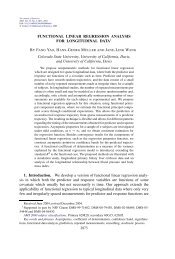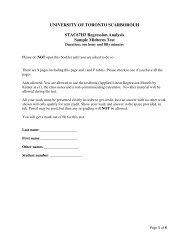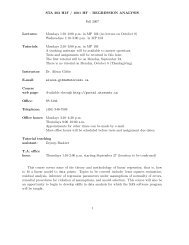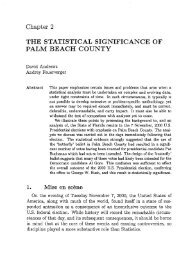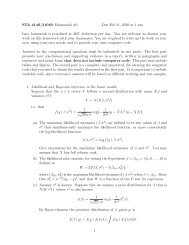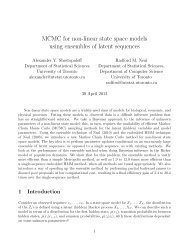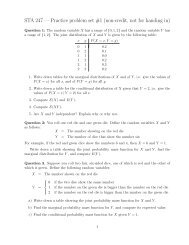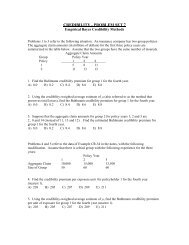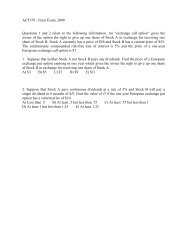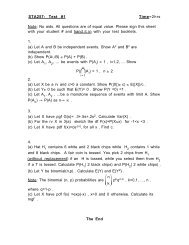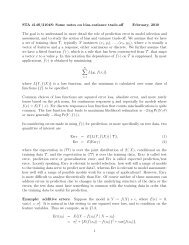Flexible modelling using basis expansions (Chapter 5) Linear ...
Flexible modelling using basis expansions (Chapter 5) Linear ...
Flexible modelling using basis expansions (Chapter 5) Linear ...
You also want an ePaper? Increase the reach of your titles
YUMPU automatically turns print PDFs into web optimized ePapers that Google loves.
STA 450/4000 S: February 2 2005<strong>Flexible</strong> <strong>modelling</strong> <strong>using</strong> <strong>basis</strong> <strong>expansions</strong> (<strong>Chapter</strong> 5)◮ <strong>Linear</strong> regression: y = Xβ + ɛ, ɛ ∼ (0, σ 2 )◮ ’Smooth’ regression: y = f (X) + ɛ: f (X) = E(Y | X) to bespecified◮ <strong>Flexible</strong> linear <strong>modelling</strong>f (X) = Σ M m=1 β mh m (X)◮ This is called a linear <strong>basis</strong> expansion, and h m is the mth<strong>basis</strong> function◮ For example if X is one-dimensional:f (X) = β 0 + β 1 X + β 2 X 2 , orf (X) = β 0 + β 1 sin(X) + β 2 cos(X), etc.◮ Simple linear regression has h 1 (X) = 1, h 2 (X) = X.Several other examples on p.116: , 1
Regression splines◮ Polynomial fits: h j (x) = x j , j = 0, . . . , m◮ Fit <strong>using</strong> linear regression with design matrix X, whereX ij = h j (x i )◮ Justification is that any ’smooth’ function can beapproximated by a polynomial expansion (Taylor series)◮ Can be difficult to fit numerically, as correlation betweencolumns can be large◮ May be useful locally, but less likely to work over the rangeof X◮ (rafal.pdf) f (x) = x 2 sin(2x), ɛ ∼ N(0, 2), n = 200◮ It turns out to be easier to find a good set of <strong>basis</strong> functionsif we only consider small segments in the X-space (localfits)◮ Need to be careful not to overfit, since we are <strong>using</strong> only afraction of the data: , 2
Regression splines◮ Constraints on derivatives can be incorporated into the<strong>basis</strong>: {1, X, X 2 , X 3 , (X − ξ 1 ) 3 + , . . . , (X − ξ k) 3 + } thetruncated power <strong>basis</strong>◮ procedure: choose number (K ) and placement of knotsξ 1 , . . . ξ K◮ construct X matrix <strong>using</strong> truncated power <strong>basis</strong> set◮ run linear regression with ?? degrees of freedom◮ Example: heart failure data from <strong>Chapter</strong> 4 (462observations, 10 covariates): , 4
Regression splines> bs.sbp dim(bs.sbp)[1] 462 4 # this is the <strong>basis</strong> matrix> bs.sbp[1:4,]1 2 3 4[1,] 0.16968090 0.4511590 0.34950621 0.029653925[2,] 0.35240669 0.4758851 0.17002102 0.001687183[3,] 0.71090498 0.1642420 0.01087580 0.000000000[4,] 0.09617733 0.3769808 0.44812470 0.078717201: , 5
Regression splines◮ The B-spline <strong>basis</strong> is hard to described explicitly (seeAppendix to Ch. 5), but can be shown to be equivalent tothe truncated power <strong>basis</strong>:◮ In R library(splines): bs(x, df=NULL, knots=NULL,degree=3,intercept=FALSE,Boundary.knots=range(x))◮ Must specify either df or knots. For the B-spline <strong>basis</strong>, #knots = df - degree (degree is usually 3: see ?bs).◮ The knots are fixed, even if you use df (see R code)◮ Natural cubic splines have better endpoint behaviour(linear) (p.120, 121)◮ ns(x, df=NULL, knots=NULL,degree=3,intercept=FALSE,Boundary.knots=range(x))◮ For natural cubic splines, # knots = df - 1: , 6
Example: heart dataRegression splines (p.120) refers to <strong>using</strong> these <strong>basis</strong>matrices in a regression model.> ns.hr.glm summary(ns.hr.glm)Call:glm(formula = chd ˜ ns.sbp + ns.tobacco + ns.ldl + famhist +ns.obesity + ns.alcohol + ns.age, family = binomial, data = hr)Deviance Residuals:Min 1Q Median 3Q Max-1.7245 -0.8265 -0.3884 0.8870 2.9588Coefficients:Estimate Std. Error z value Pr(>|z|)(Intercept) -2.1158 2.4067 -0.879 0.379324ns.sbp1 -1.4794 0.8440 -1.753 0.079641 .ns.sbp2 -1.3197 0.7632 -1.729 0.083769 .ns.sbp3 -3.7537 2.0230 -1.856 0.063520 .ns.sbp4 1.3973 1.0037 1.392 0.163884ns.tobacco1 0.6495 0.4586 1.416 0.156691ns.tobacco2 0.4181 0.9031 0.463 0.643397ns.tobacco3 3.3626 1.1873 2.832 0.004625 **ns.tobacco4 3.8534 2.3769 1.621 0.104976ns.ldl1 1.8688 1.3266 1.409 0.158933ns.ldl2 1.7217 1.0320 1.668 0.095248 .ns.ldl3 4.5209 2.9986 1.508 0.131643ns.ldl4 3.3454 1.4523 2.304 0.021249 *famhistPresent 1.0787 0.2389 4.515 6.34e-06 ***ns.obesity1 -3.1058 1.7187 -1.807 0.070748 .: ,ns.obesity2 -2.3753 1.2042 -1.972 0.048555 *ns.obesity3 -5.0541 3.8205 -1.323 0.1858717
Example: heart dataThe individual coefficients don’t mean anything, we need toevaluate groups of coefficients. We can do this with successivelikelihood ratio tests, by hand, e.g.> summary(glm(chd˜ns.sbp+ns.ldl+famhist+ns.obesity+ns.alcohol+ns.age,+ family=binomial, data=hr)) # I left out tobacco... stuff omittedNull deviance: 596.11 on 461 degrees of freedomResidual deviance: 469.61 on 440 degrees of freedomAIC: 513.61Number of Fisher Scoring iterations: 5> 469.61-457.63[1] 11.98> pchisq(11.98,4)[1] 0.9824994> 1-.Last.value[1] 0.01750061 # doesn’t agree exactly with the book, but closeSee Figure 5.4: , 8
Example: heart dataThe function stepAIC does all this for you:> ns.hr.step #> # Here we are at Table 5.1; note that alcohol has been dropped from the> # model: , 9
The function stepAIC does all this for you:> ns.hr.step #> # Here we are at Table 5.1; note that alcohol has been dropped from the> # model2005-02-08Example: heart dataThe degrees of freedom fitted are the number of columns in the<strong>basis</strong> matrix (+ 1 for the intercept). This can also be computed as thetrace of the hat matrix, which can be extracted from lm. There issomething analogous for glm, because glm’s are fitted <strong>using</strong>iteratively reweighted least squares.
Smoothing splines◮ This is an approach closer to ridge regression. Put knots ateach distinct x value, and then shrink the coefficients bypenalizing the fit . (Figure 5.6)◮subject to:argmin βΣ i(yi − Σ j β j h j (x i ) ) 2β T Ωβ < c◮ with no constraint we get usual least squares◮ Ω controls the smoothness of the final fit:∫Ω jk = h j ′′ (x)h′′ k (x)dx◮ This solves the variational problemargmin fΣ i (y i − f (x i )) 2 + λ∫ ba{f ′′ (t)} 2 dt◮ the solution is a natural cubic spline with knots at each x i
Smoothing splines◮ How many parameters have been fit?◮ It can be shown that the solution to the smoothing splineproblem gives fitted values of the formŷ = S λ y◮ By analogy with ordinary regression, define the effectivedegrees of freedom (EDF) astrace S λ◮ Reminder: ridge regressionmin Σ N i=1 (y i − β 0 − β 1 x i1 − · · · − β p x ip ) 2 + λΣ pβj=1 β2 j⇐⇒ minβΣ N i=1 (y i − β 0 − β 1 x i1 − · · · − β p x ip ) 2 s.t. Σ p j=1 β2 j ≤ shas solutionŷ ridge = X(X T X + λI) −1 X T y: , 12
Smoothing splines◮ In the smoothing case it can be shown thatŷ smooth = H(H T H + λΩ H ) −1 H T ywhere H is the <strong>basis</strong> matrix. See p. 130, 132 for details onS λ , the smoothing matrix.◮ How to choose λ?◮ a) Decide on df to be used up, e.g.smooth.spline(x,y,df=6), note that increasing dfmeans less ’bias’ and more ’variance’.◮ b) Automatic selection by cross-validation (Figure 5.9): , 13
Smoothing splinesA smoothing spline version of logistic regression is outlined in§5.6, but we’ll wait till we discuss generalized additive models.An example from the R help file for smooth.spline:> data(cars)> attach(cars)> plot(speed, dist, main = "data(cars) & smoothing splines")> cars.spl (cars.spl)Call:smooth.spline(x = speed, y = dist)Smoothing Parameter spar= 0.7801305 lambda= 0.1112206 (11 iterations)Equivalent Degrees of Freedom (Df): 2.635278Penalized Criterion: 4337.638GCV: 244.1044> lines(cars.spl, col = "blue")> lines(smooth.spline(speed, dist, df=10), lty=2, col = "red")> legend(5,120,c(paste("default [C.V.] => df =",round(cars.spl$df,1)),+ "s( * , df = 10)"), col = c("blue","red"), lty = 1:2,+ bg=’bisque’)> detach(): , 14




